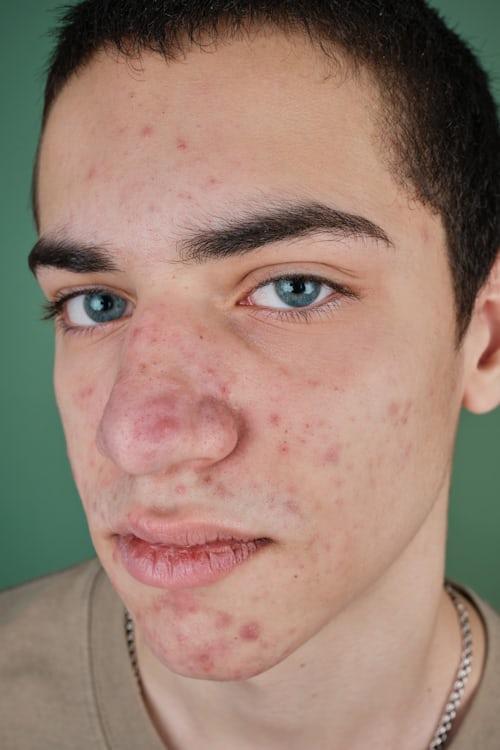Laser therapy is one of the most effective methods of treating acne scars. The technique involves utilizing a focused light energy to smooth acne spots by targeting acne-causing factors, including bacteria and excess sebum production.
Besides clearing acne scars, laser therapy may also alleviate dermal inflammation, reverse hyperpigmentation, and stimulate skin cell regeneration.
But despite its efficacy, results from laser therapy may not set in sooner than you anticipated. So, it’s important to manage your expectations.
Like most acne treatments, the effectiveness of laser therapy depends on several factors.
Read below as we delve into those aspects.
How Soon Does Laser Acne Treatment Take To Work?
The initial effects from acne laser treatment can set in within a week after the first session. That makes laser therapy one of the most effective acne scar treatments.
Comparatively, the effects from topical solutions may take several months to kick in.
However, don’t expect all the scars to disappear within a week or two. Consistency is paramount to unlocking the benefits of laser acne treatment.
Your dermatologist will recommend the ideal number of treatments required and the frequency and duration of each therapy to achieve complete recovery. Considering that the skin around acne spots must regenerate for acne scars to disappear, full recovery from laser acne treatment may take up to eighteen months.
Accelerating Acne Scar Healing With Cutting-edge Technology
Acne scars are not only a blemish on the skin. They can also adversely impact your self-esteem and lead to social isolation. Therefore, waiting for eighteen months to fully recover from these spots may feel like an eternity.
Fortunately, you can expedite the healing process using high-end cosmetic solutions like the erbium glass laser technology.
Erbium glass laser technology, more commonly shortened as Er:Glass technology, is a non-ablative laser acne treatment technique that utilizes a laser with infrared wavelengths around 1550 nm to stimulate collagen production on the skin’s epidermis.
Collagen is the main structural protein that constitutes skin tissues. By activating collagen production, Er:Glass lasers promote skin regeneration while firming skin texture and tone.
The efficacy of erbium glass laser technology in treating acne scars has been scientifically investigated, and the findings corroborate numerous anecdotal reports. According to one study, subjecting acne scars to infrared light wavelengths of 1550 nm can clear the unsightly spots without triggering worrying side effects.
Er:Glass’ efficacy is rooted in its ability to target acne scars, minimizing resultant inflammation while soothing away the spots.
The technique also calms overactive sebaceous glands. As such, it can regulate long-term sebum production and minimize the risk of future acne breakouts.
Er:Glass is non-ablative, too, making it safe for all skin types. You don’t need to worry about side effects or downtimes. And besides acne scars, the technique might also help in treating androgenetic alopecia and hyperpigmentation.
Other Technologies for Treating Acne Scars
1. Non-Ablative Techniques
Non-ablative laser acne therapies are preferable for their non-invasiveness, making them safe for all skin types.
Other noteworthy non-ablative methods besides Er:Glass include:
- Pulsed Dye Lasers
- Nd: YAG Lasers
- Low-Level Laser Therapy (LLLT)
- High Intensity Laser Therapy (HILT)
2. Ablative Techniques
Ablative laser therapies involve removing the epidermis before administering a focused light beam to the dermis. It’s based on the theory that exposing the epidermis enables laser beams to penetrate the dermis more effectively, promoting new collagen production.
Examples of ablative acne scar treatments include the Carbon Dioxide (CO2) Laser and the Opus Plasma-RF technology.
However, the fact that ablative techniques involve scraping the skin makes them unideal for patients with sensitive skin. These treatments also induce more severe adverse effects and a longer downtime than non-ablative therapies.
3. Fractionated Lasers
Fractionated lasers are a middle ground between ablative and non-ablative laser acne treatments. They exert their influence on both the epidermis and dermis, making them remarkably effective at activating collagen production.
A noteworthy example is Fraxel lasers.
Other Factors Determining the Duration of Effects From Laser Acne Treatments
1. Nature of Scars
Acne scars are broadly classified as atrophic and hypertrophic. Atrophic scars are depressed while hypertrophic ones are raised.
As atrophic scars occur deeper into the skin’s surface, they’re usually challenging to remove and may require more extended treatment.
2. Number and Severity of Scars
Whether atrophic or hypertrophic, acne scars are easier to treat if they’re few and less widespread.
3. Number and Duration of Treatments
Dermatologists generally recommend 3 – 6 laser therapies, administered several weeks apart.
For noticeable improvements, each session should preferably last 30 – 45 minutes.
4. Skin Type
The effects of laser therapy on the skin varies significantly by skin type. Patients with oily and sensitive skin may require longer treatments than normal and combination skin.
Summary
Acne scars are a natural effect of acne treatments. While they ultimately resolve independently, these marks can blemish your skin while they last.
Laser therapy has proven effective at treating acne scars, producing initial results in as little as one week.
However, laser therapy may take up to eighteen months to exert its full effects. That’s because the skin cells and tissues around the treated spots must completely regenerate for the unsightly marks to disappear.
It’s also worth noting that the efficacy of laser acne treatment depends on the methodology used, the nature of the scars, and your skin type. To improve the treatment’s outcome, high-end cosmetic technologies like Er:Glass technology should be used, and a board-certified dermatologist should administer the treatment.

